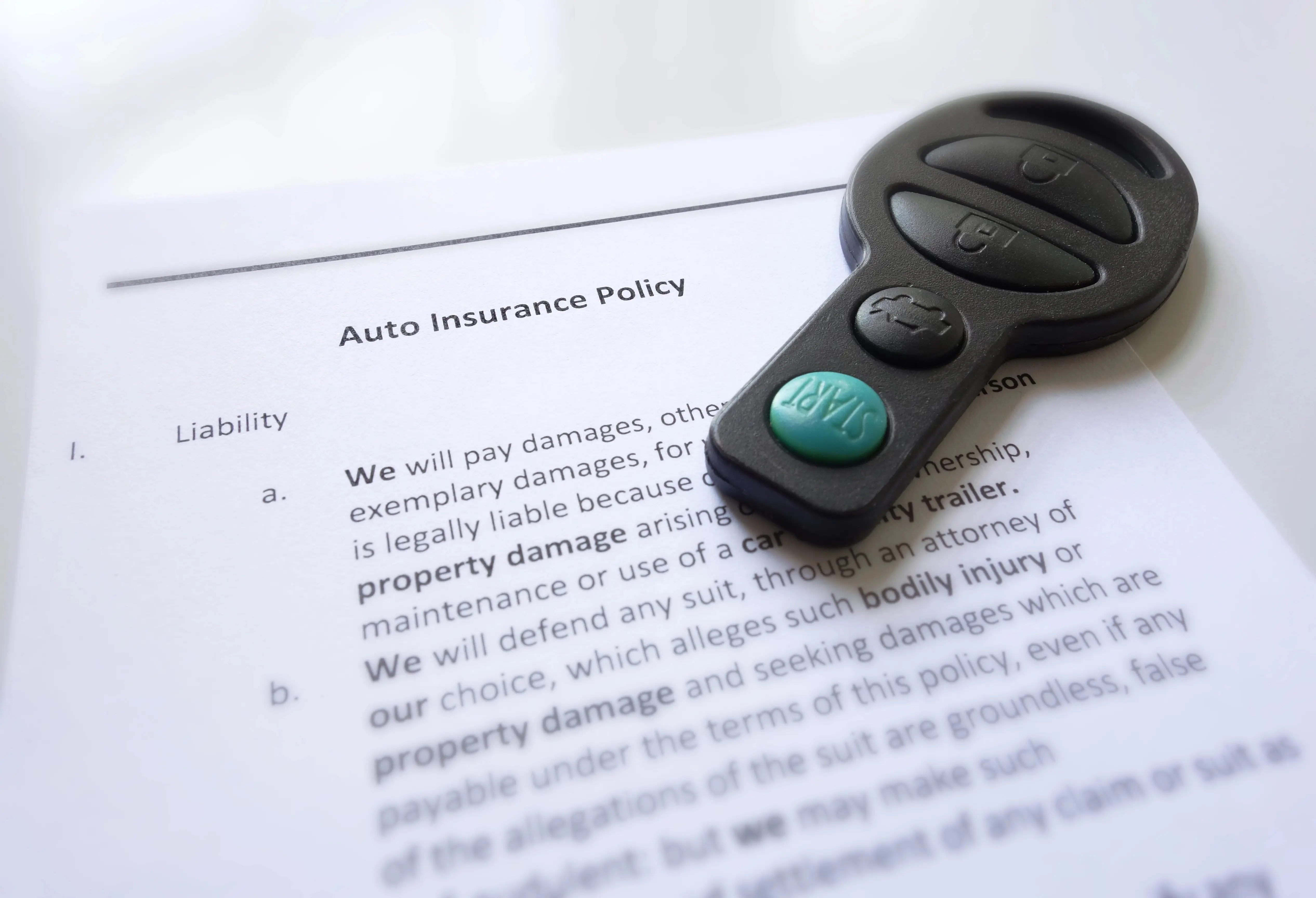A car insurance premium is the amount you pay an insurer in exchange for auto insurance coverage. Premiums can be paid in a lump sum all at once or in equal monthly payments. Your auto insurance rates vary based on a number of factors — some you can control, and others you can’t.
Car insurance premiums can often be paid monthly, biannually or annually. If you pay monthly, your insurer may charge an installment fee.
One way to avoid extra fees is to pay the full premium up front, rather than installments. You can set up a savings account dedicated to your car insurance premium and contribute to it monthly so you’ll have the funds when the policy renews.
How are car insurance premiums calculated?
Insurers calculate your premium based on their perceived likelihood of you submitting a claim. The higher the likelihood, the higher your premium.
Factors like your driving history, location and age all contribute to your premium cost. The more expensive your car is to repair or replace, the higher your insurance premium will be. While coverage types and limits factor into the pricing, other factors impact car insurance premiums as well.
Even after you’ve locked in your car insurance premium, the rates can change when your policy renews in six to 12 months. That’s why it’s important to shop for auto insurance regularly — to ensure you aren’t overpaying.
Key factors that affect your car insurance premium
There are numerous factors that impact your car insurance premium, which may also cause your rates to increase at renewal.
- Driving record. Getting tickets or being in accidents indicates you’re a higher risk of future claims.
- Age and demographics. Insurance companies price car insurance premiums based on information like your age and where you live, which correlate to your likelihood of an accident.
- Car make and model. Your vehicle type may indicate a higher likelihood of accident or theft. Expensive, unique, or classic cars tend to require costly repairs.
- Mileage. The more you drive, the more likely it is that you’ll get a ticket or be in an accident.
- Coverage types and limits. You’ll pay for each type of insurance you select, and higher coverage limits result in higher premiums.
- Deductible. Your deductible, if you have one, is the amount you owe before the insurance company pays for any claims. A higher deductible typically lowers your premium, and a lower deductible raises it.
More: Why is my car insurance premium so high?
Types of car insurance
Each type of car insurance protects drivers against certain risks. You can choose coverage types and adjust limits to be sure your coverage meets your needs without going over budget.
You can also customize your car insurance policy by adding other coverages to cover specific types of risks, like gap insurance, rideshare coverage and new vehicle replacement.
More: Compare the different types of car insurance
-
Liability
-
Collision
-
Comprehensive
-
Uninsured/underinsured motorist (UM/UIM)
-
Personal injury protection (PIP)
-
Medical payments (MedPay)
Compare car insurance premiums by coverage level and location
In the charts below, you’ll see average monthly car insurance premiums for a variety of drivers to help you understand how different factors can affect your auto insurance rate.
More: The average cost of car insurance
Car car insurance costs by coverage level
How much you pay for car insurance can vary widely based on the coverage levels you choose. Drivers on a budget may be tempted to start with the minimum auto insurance levels required by law to save money. However, having less coverage can put you at a higher risk if you’re in an accident because you may not be able to replace your vehicle or cover all of the damage and medical expenses. For this reason, drivers often choose full coverage to protect themselves financially.
According to Jerry’s car insurance analysis, more coverage doesn’t always lead to higher premiums. The chart below highlights the average monthly cost for common liability limits.
|
Liability Limits
|
Avg Monthly Quote
|
|---|
|
Liability Limits
|
Avg Monthly Quote
|
|---|---|
| State Minimum | $214 |
| 50/100 | $333 |
| 250/500 | $265 |
| 100/300 | $399 |
Average car insurance premiums by state
Where you live can impact your auto insurance premium as well. While your premium can vary based on the city and ZIP code you live in, this chart shows the average car insurance premiums by state for full coverage.
|
State
|
Avg Monthly Quote
|
|---|
|
State
|
Avg Monthly Quote
|
|---|---|
| $162 | |
| $241 | |
| $497 | |
| $308 | |
| $222 | |
| $397 | |
| $345 | |
| $129 | |
| $327 | |
| $196 | |
| $322 | |
| $414 | |
| $259 | |
| $356 | |
| $319 | |
| $200 | |
| $384 | |
| $145 | |
| $279 | |
| $909 | |
| $219 | |
| $273 | |
| $331 | |
| $190 | |
| $311 | |
| $146 | |
| $405 | |
| $294 | |
| $410 | |
| $477 | |
| $229 | |
| $453 | |
| $315 | |
| $330 | |
| $145 | |
| $202 | |
| $231 | |
| $154 | |
| $216 | |
| $144 | |
| $224 | |
| $233 | |
| $190 | |
| $389 | |
| $159 | |
| $327 | |
| $241 | |
| $332 | |
| $296 |
Average car insurance premiums by age
As you gain experience behind the wheel, your car insurance premium tends to decrease. However, rates may rise again as you reach your 70s. This chart shows the average insurance costs for full coverage based on your age.
|
Age Group
|
Avg Monthly Quote
|
|---|
|
Age Group
|
Avg Monthly Quote
|
|---|---|
| 55-64 | $244 |
| 45-54 | $264 |
| 25-34 | $350 |
| 18-20 | $607 |
| 21-24 | $442 |
| 35-44 | $291 |
| 65+ | $245 |
| $129 | |
| $327 | |
| $196 | |
| $322 | |
| $414 | |
| $259 | |
| $356 | |
| $319 | |
| $200 | |
| $384 | |
| $145 | |
| $279 | |
| $909 | |
| $219 | |
| $273 | |
| $331 | |
| $190 | |
| $311 | |
| $146 | |
| $405 | |
| $294 | |
| $410 | |
| $477 | |
| $229 | |
| $453 | |
| $315 | |
| $330 | |
| $145 | |
| $202 | |
| $231 | |
| $154 | |
| $216 | |
| $144 | |
| $224 | |
| $233 | |
| $190 | |
| $389 | |
| $159 | |
| $327 | |
| $241 | |
| $332 | |
| $296 |
9 tips to lower car your car insurance premium
There are steps you can take to lower your auto insurance premiums. Some take time to implement, while others can save you money right away.
Shop around for better rates and coverage
One of the best ways to save money on car insurance premiums is by comparing car insurance quotes regularly. Each insurance company has an ideal customer type, which is why the best insurance company for you may be different from the best one for your friend or neighbor.
While your policy may have been perfect for you when you bought it, when it renews, your insurer may no longer offer the best rate.
Lower coverage levels
Auto insurance premiums are directly related to how much coverage you have. Evaluate your policy limits to ensure you’re not overinsured. Having robust coverage is beneficial, but you may have more than you need.
Though leased and financed vehicles typically require full coverage car insurance, once you own your car outright, you can choose the coverage that fits your budget and needs. Keep in mind that lower coverage levels mean you’d have to pay steep out of pocket costs if you’re in an accident.
These are the average quotes that real Jerry customers have received for their state’s mandated minimum coverage, with and without full coverage added to their policy.
|
Has Full Coverage
|
Avg Monthly Quote
|
|---|
|
Has Full Coverage
|
Avg Monthly Quote
|
|---|---|
| Yes | $337 |
| No | $145 |
| $350 | |
| $607 | |
| $442 | |
| $291 | |
| $245 | |
| $129 | |
| $327 | |
| $196 | |
| $322 | |
| $414 | |
| $259 | |
| $356 | |
| $319 | |
| $200 | |
| $384 | |
| $145 | |
| $279 | |
| $909 | |
| $219 | |
| $273 | |
| $331 | |
| $190 | |
| $311 | |
| $146 | |
| $405 | |
| $294 | |
| $410 | |
| $477 | |
| $229 | |
| $453 | |
| $315 | |
| $330 | |
| $145 | |
| $202 | |
| $231 | |
| $154 | |
| $216 | |
| $144 | |
| $224 | |
| $233 | |
| $190 | |
| $389 | |
| $159 | |
| $327 | |
| $241 | |
| $332 | |
| $296 |
Increase your deductible
Raising your deductible is an easy way to maintain higher levels of coverage while keeping the premium affordable. Increasing your deductible signals to the insurance company that you’re willing to pay more in case of a claim, which can help lower your premium.
Try to balance an affordable premium with a deductible that you could manage, should you need to pay it unexpectedly.
This chart highlights the potential savings for a typical driver if they have a low deductible versus one that is higher.
Boost your credit score
In every state except California, Hawaii, Massachusetts and Michigan, your credit score impacts how much you’ll pay for car insurance. Improving your score could lower your auto insurance premium, qualify you with additional insurance companies or allow you to increase coverage without paying more.
These four simple steps can increase your score while shopping for car insurance coverage:
- Keep debt low. When your credit card balances are too close to your credit limit, your credit score can decrease. Paying down credit card debt can boost your score. Many financial experts recommend keeping your credit utilization below 30% of your credit limit.
- Make bill payments on time. Payment history has the largest impact on your credit score. Consider setting up automatic payments of the minimum amount due to avoid late fees and negative impacts to your credit.
- Avoid unnecessary inquiries. Each time you apply for credit, your credit score can drop by up to five points. This impact is temporary and typically lasts up to a year.
- Keep your oldest accounts open. The average age of your accounts is another factor in your credit score. By keeping your oldest accounts open, you’ll keep your average age higher and contribute to a higher credit score.
More: Learn about credit-based insurance scores
|
Credit Score
|
Avg Monthly Quote
|
|---|
|
Credit Score
|
Avg Monthly Quote
|
|---|---|
| 750+ | $326 |
| <550 | $348 |
| 660-750 | $374 |
| 550-659 | $349 |
| $442 | |
| $291 | |
| $245 | |
| $129 | |
| $327 | |
| $196 | |
| $322 | |
| $414 | |
| $259 | |
| $356 | |
| $319 | |
| $200 | |
| $384 | |
| $145 | |
| $279 | |
| $909 | |
| $219 | |
| $273 | |
| $331 | |
| $190 | |
| $311 | |
| $146 | |
| $405 | |
| $294 | |
| $410 | |
| $477 | |
| $229 | |
| $453 | |
| $315 | |
| $330 | |
| $145 | |
| $202 | |
| $231 | |
| $154 | |
| $216 | |
| $144 | |
| $224 | |
| $233 | |
| $190 | |
| $389 | |
| $159 | |
| $327 | |
| $241 | |
| $332 | |
| $296 |
Eliminate unnecessary coverages
Your car insurance needs change over time, so you may not need every type of coverage you’ve carried for the last few years. Review your policy to make sure you’re not paying for unnecessary coverage.
For example, as your car ages, its value can drop significantly. Some people eliminate or reduce collision coverage as their car loses value, which can provide meaningful savings if you decide to eliminate it.
Another example is rental car reimbursement. While you may be inconvenienced without a vehicle while your car is being repaired, if you work from home, live near public transit or have access to another vehicle, you may eliminate this coverage to lower your premium.
Bundle home and auto insurance policies
Bundling your home and auto insurance is a common way to reduce costs.
If you don’t own your home, you may qualify for a discount if you have renter’s, life, or umbrella insurance from the same company that provides your auto insurance.
Explore discounts
Many providers offer car insurance discounts, and you can have multiple discounts on your policy. It’s wise to be sure that all possible discounts are applied before you buy a new policy.
Common auto insurance discounts include:
- Safe driver. Insurance companies reward drivers who don’t get tickets, have accidents or file claims. Keeping your driving record clean can earn you lower rates.
- Good student. Students who earn good grades may qualify for lower rates. If you have a teenage driver, this can help reduce the cost of their car insurance premium.
- Driving course. Taking a driving course can refresh your memory on the rules of the road and get you a discount.
- Low mileage. The fewer miles you drive, the less likely you are to get into an accident. Insurance companies may offer lower rates to people who dress less.
- Paperless statements. Signing up for online statements is an environmentally friendly way to save money.
- Organization affiliations and memberships. Some organizations negotiate discounts with insurers to save their members money.
Consider behavior-based pricing
Many insurance companies offer telematics programs that track your driving behaviors and price your car insurance premium accordingly. When you sign up for a usage-based policy, the insurer may provide a device to plug in under your car’s dashboard or ask you to download a mobile app. The insurer then tracks your speed, miles driven, braking and other factors, to price your premium.
Though this method of insurance pricing can save some drivers money, if the insurer deems your driving habits unsafe, you could end up paying a higher premium.
Avoid accidents and claims
Being a safe driver is one of the best ways to keep car insurance costs low. When you have an accident or get a ticket, not only will your insurance rates go up, but you can also lose any good-driver discounts on your policy.
When filing a claim, compare the size of your deductible, if you have one, to the repair cost. If it makes sense to pay for the repairs yourself, you can avoid a premium increase at renewal.
FAQ
-
What is a good 6-month premium for car insurance?
-
How often do I have to pay for auto insurance?
-
How often should I shop for new car insurance?
-
What is a car insurance quote vs. a car insurance premium?
-
What is a car insurance premium vs. a deductible?
Methodology
Data included in this analysis comes from policies that Jerry has quoted within the last 6 months for drivers with a clean record and that have full coverage, unless stated otherwise. Data related to violations, accidents or credit scores pull from quote data from the last 18 months. Jerry services 48 states and offers a range of insurance companies to choose from.

Lee Huffman is personal finance expert who has been writing online since 2012. After spending 18 years experience in banking, insurance and investing, Lee has a knack for translating complex financial topics into everyday language so readers can make informed decisions.
His bylines appear in more than 1,300 articles for numerous online publications, like TIME, Fortune, LendingTree, NerdWallet, Forbes, USA Today, Money, Slickdeals, Business Insider and Investopedia. Lee has an MBA in eBusiness, and he earned his Bachelors in Business Management at Pepperdine University.

Annie is a writer and editor at Jerry with more than a decade of experience writing and editing digital content. Before joining Jerry, she was an assistant assigning editor at NerdWallet. Her past work has appeared in the Associated Press, USA Today and The Washington Post. Her work has been cited by Northwestern University and Harvard Kennedy School. Annie served as a spokesperson for NerdWallet during her time at NerdWallet and has been featured in New York Magazine, MarketWatch and on local television and radio stations.
Previously, she worked at USAA and newspapers in Minnesota, North Dakota, California and Texas. She has a bachelor’s degree in journalism from the University of Minnesota.









